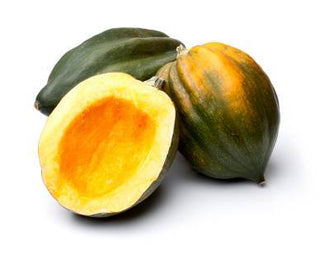(Cucurbita pepo)
A member of the Cucurbitaceae family, acorn squash is a relative of the melon and cucumber and is botanically classified as a fruit. Acorn squash along with butternut, spaghetti, pumpkin and hubbard are considered winter squashes. Unlike summer squash, winter squash are characterized by a hard outer skin that can’t be eaten. This hard skin allows these varieties to keep for several months after a fall harvest.
Indigenous to North and Central America, scientists believe the acorn squash was first cultivated for its seeds about 10,000 years ago in what is today Mexico. From there, these squash spread across the Americas and were introduced to early European settlers by the Native Americans.
About 6 inches around and weighing anywhere from 1 to 3 pounds, acorn squash have a hard outside rind with distinctive ridges. Reminiscent in shape to their namesake, the acorn, these little squash are most commonly a deep green, although recently golden and multi-colored varieties have become more readily available. Inside the orange flesh can be best described as sweet, nutty and a bit peppery.
Nutrition
Acorn squash are a nutritious, filling and low-calorie addition to any meal. Provided no butter or brown sugar is added, a one cup serving of baked acorn squash is 115 calories. This serving also provides 2 grams of protein and 9 grams of fiber.
A great source of vitamin C, acorn squash has 22.1 mg per serving, or 37% of the recommended daily intake. These little squash are also an excellent source of vitamin A providing 877 IUs or 18% of daily values. Acorn squash provides about 20% of the recommended intake for the B-vitamins thiamin and B6.
Acorn squash is an excellent source of magnesium and potassium, two minerals that play a role in blood pressure management, providing 88.2 mg and 896 mg, respectively. A serving is also an excellent source of manganese and a good source of iron, copper and calcium.
Selection and Storage
Although acorn squash can be found in grocery stores throughout the year, this small squash is best from early fall through winter.
When making your selection, look for a dry solid squash, heavy for its size and free of cuts and bruises. The rind should be smooth with a matte or dull appearance. Squash that are shiny have not reached maturity or have been waxed. Choose a squash with a dry, cork like stem. Those without a stem permit bacteria to enter the flesh.
If you are unsure about the quality of a squash, run your fingernail over it. Skin that is easily nicked or scrapped means the squash is not fully ripe.
Because acorn squash are picked at maturity, they can be stored in a cool, dry place for up to 3 months. Refrigeration should be minimal. Refrigerating for more than 2 weeks will increase the rate of deterioration. If you do refrigerate your squash, make sure it is already cut and the pieces are wrapped tightly in plastic.
If you are selecting pre-cubed squashed at your grocery store look for a squash with deep colored flesh – the deeper the color the sweeter the squash.
Recipes
Although acorn squash are most commonly baked, they can be microwaved, sautéed or steamed. These little squash are also wonderful stuffed with a wide variety of fillings. Acorn squash are popular because of their small size; one squash can be halved and baked to make two generous servings.
Because of their hard rind, acorn squash can be very difficult to slice. A sturdy knife is essential to get the job done. If you are struggling, pierce the squash in a few places and microwave on high for 1-2 minutes. Let stand before slicing.
Like other hard squashes, the fibers and seeds need to be removed from the center of acorn squash before cooking. If baking, cut a slice off each rounded edge so that each half does not roll in the dish. Place in a baking dish with about a ¼ inch of water. Brush the inside of each half with a bit of olive oil instead of butter. Add ginger, cinnamon, black pepper, red pepper and salt to bring out the flavor without adding extra calories. At 400 degrees, bake for 45-60 minutes or until the flesh is tender.
Because of their low calories yet hearty taste, acorn squash are the ideal comfort food. Try Chicken Cassoulet with Acorn Squash.
An important note about cooking with squash – with the exception of spaghetti squash, any winter squash can be substituted for another in recipes. Enjoy whatever is freshest at your local farmers market!
Fun Facts
Squash was one of the “Three Sisters” planted by Native Americans. The Three Sisters were the three main indigenous plants used for agriculture: corn, beans and squash.

